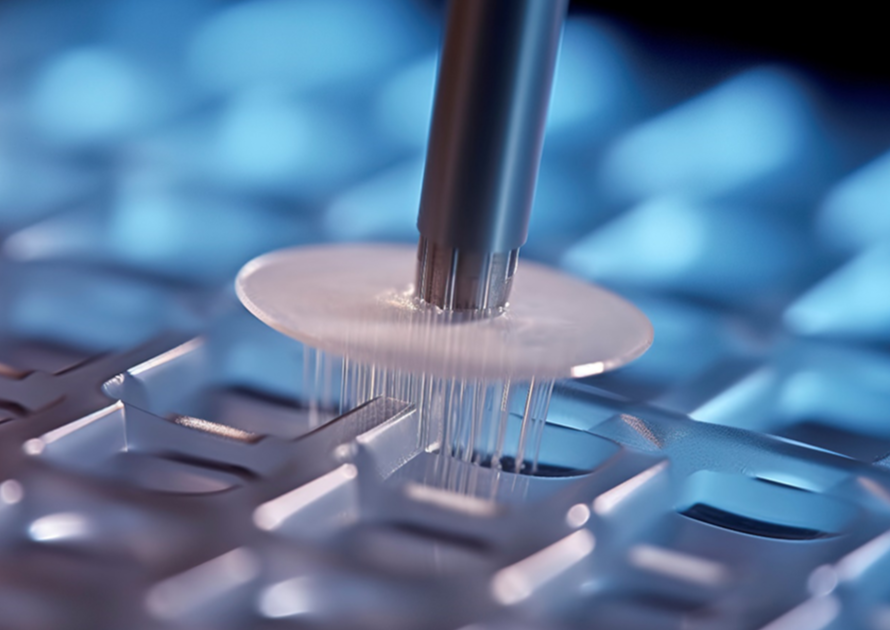Picture minuscule couriers darting between cells, transporting vital parcels. These messengers, known as extracellular vesicles (EVs), are a major focal point in the field of biology due to their potential to transform our comprehension of health and illness. EVs are minute bubbles discharged by cells, ferrying proteins, lipids, and even genetic material to other cells. They function as a sophisticated communication network that influences a wide array of biological processes.
Nevertheless, investigating these tiny messengers has posed challenges. Conventional methods for isolating EVs are sluggish, and unwieldy and can harm the fragile cargo they carry. This is where a novel technology called label-free lab-on-a-chip comes into play.
Lab-on-a-chip: A Powerful Tool for EV Research
Lab-on-a-chip devices are miniature marvels. Imagine a tiny chip with microfluidic channels that can separate, analyze, and even manipulate EVs. These devices offer a game-changing approach to EV research. Lab-on-a-chip devices can analyze EVs in minutes, compared to hours or days with traditional methods. They also allow for the isolation of EVs with exceptional purity, minimizing contamination from other cellular components. Unlike traditional methods that rely on tags to identify EVs, lab-on-a-chip devices can analyze them in their natural state, preserving their integrity.
Recent advancements have led to the development of label-free lab-on-a-chip devices specifically designed for EVs. These devices use various techniques, such as size-based filtering or electrical fields, to separate EVs based on their unique properties.
One such example is a device developed by researchers at the University of Cincinnati. This chip uses tiny insulating posts and electrical fields to trap and isolate circulating small EVs. The isolated EVs can then be further analyzed to understand their contents and functions.
Revolutionizing EV Research
Label-free lab-on-a-chip technology holds immense promise for the future of EV research:
- Biomarker discovery: EVs are treasure troves of potential biomarkers for diseases like cancer, Alzheimer’s, and heart disease. Lab-on-a-chip devices can efficiently identify and characterize these biomarkers, aiding in early diagnosis.
- Drug Delivery: EVs can be harnessed as natural carriers for drug delivery. Lab-on-a-chip devices can help engineer EVs with specific targeting abilities, ensuring drugs reach the right cells.
- Personalized Medicine: By analyzing patient-derived EVs, these devices can provide personalized insights for diagnosis and treatment, paving the way for a more tailored approach to healthcare.
The Future of EVs is Bright
The outlook for Electric Vehicles (EVs) is promising. Extracellular vesicles, small containers with the potential to revolutionize our knowledge of health and illness, can be unlocked using label-free lab-on-a-chip technology. This advancement could pave the way for new diagnostic methods, precise treatments, and ultimately contribute to a healthier future.
Reference:
- Cheng, S., Li, Y., Yan, H., Wen, Y., Zhou, X., Friedman, L., & Zeng, Y. (2021). Advances in microfluidic extracellular vesicle analysis for cancer diagnostics. Lab on a Chip, 21(17), 3219–3243. doi:10.1039/d1lc00443c. https://pubs.rsc.org/en/content/articlelanding/2021/lc/d1lc00443c
- Friedrich, R., Block, S., Alizadehheidari, M., Heider, S., Fritzsche, J., Esbjörner, E. K., … Bally, M. (2017). A nano flow cytometer for single lipid vesicle analysis. Lab on a Chip, 17(5), 830–841. doi:10.1039/c6lc01302c. https://pubs.rsc.org/en/content/articlelanding/2017/lc/c6lc01302c
- Seder, I., Moon, H., Kang, S. J., Shin, S., Rhee, W. J., & Kim, S.-J. (2022). Size-selective filtration of extracellular vesicles with a movable-layer device. Lab on a Chip, 22(19), 3699–3707. doi:10.1039/d2lc00441k. https://pubs.rsc.org/en/content/articlelanding/2022/lc/d2lc00441k
- Abreu, C. M., Costa-Silva, B., Reis, R. L., Kundu, S. C., & Caballero, D. (2022). Microfluidic platforms for extracellular vesicle isolation, analysis and therapy in cancer. Lab on a Chip, 22(6), 1093–1125. doi:10.1039/d2lc00006g. https://pubs.rsc.org/en/content/articlelanding/2022/lc/d2lc00006g




